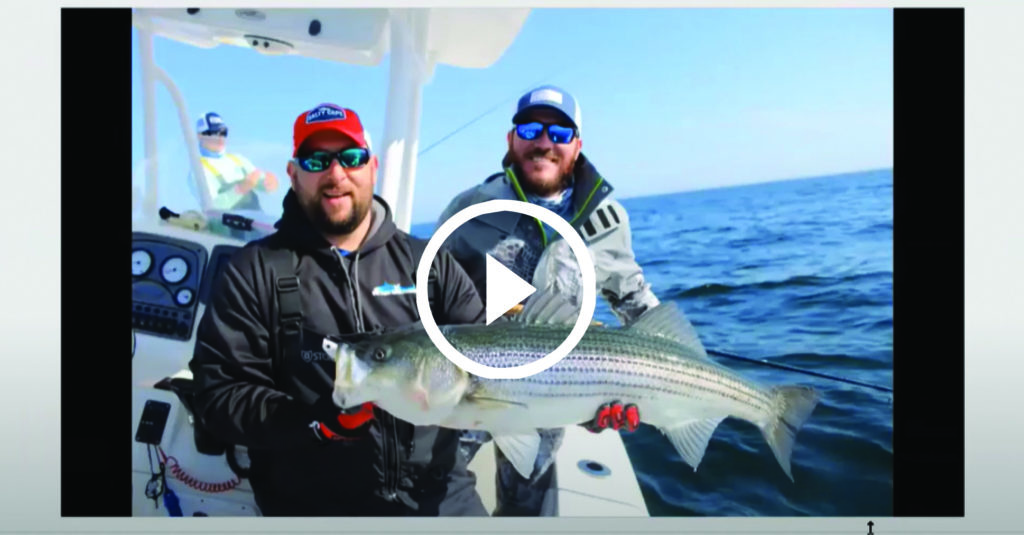By Warren Winders
Southeastern Mass. Trout Unlimited
North River near New Inlet, June 1956
My first sighting of a striped bass took place on the deck of a lobster boat. The sun was just rising above the blue horizon of the Atlantic as we were rounding the Spit and heading into the channel that passes under the shadow of Fourth Cliff and from there to the open ocean. From our position we could see a white lapstrake boat with a small cabin forward making its way into the river trolling a couple of lines off its stern. Just as it passed the rocks that jut out from the cliff, one of the rods lurched into a deep bend.
By the time we motored up along side the fishing boat, the occupants were hauling their catch over the transom. I can still picture the fish glistening in the morning light, its white side broken by lines that appeared to be almost dark blue in the slanting rays of the early morning sun. The fish’s broad tail flailed at the air as the anglers pulled it aboard. “What is that?” I asked my father when he came to my side of the boat for a better view of the action. “It’s a striped bass, a nice one,” he said.
It was the biggest fish that I’d ever seen, and at the ripe old age of nine I considered myself to be an expert fisherman. Suddenly, the yellow perch, hornpout and chain pickerel that had been my obsession seemed puny and plain. And pulling lobster pots with my father and his buddy now seemed like a boring waste of time. We could be catching striped bass.
Almost a decade would pass before my dream of catching a striped bass would come to pass. It was a 17” schoolie that had the temerity to attack my only bass plug, a blue and white Atom Popper, a device that to this day is the ugliest fishing lure ever to be mass produced by man. And stripers, even small ones still love to attack it. That alone tells us something about striped bass.
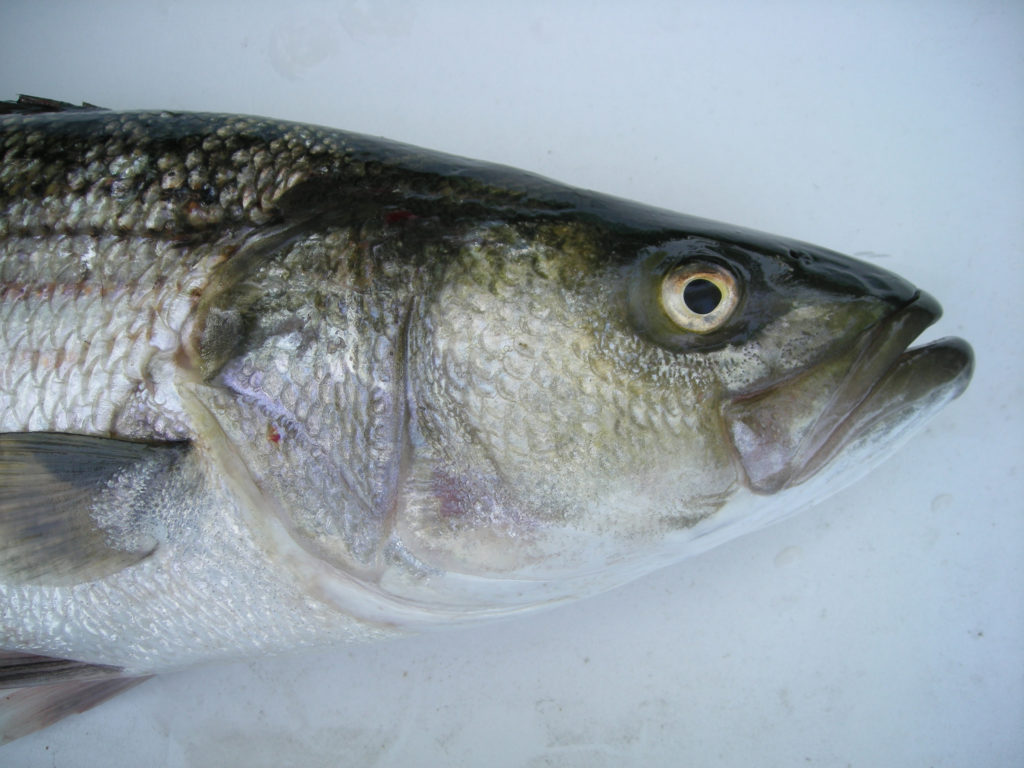 Stripers
Stripers
Striped bass belong to the family of what is known as the temperate basses. Stripers, or rockfish as they are called in the Chesapeake, are an anadromous fish that has to spawn just above tide in the fresh water of coastal rivers. Their range along the Atlantic coast extends from Florida’s Saint John River up to the rivers entering the Gulf of Lawrence in Canada. Populations of striped bass are also found in a few rivers entering the Gulf of Mexico. In 1879 and again in 1881, a small number of striped bass (435) were introduced to the West Coast where they thrived in San Francisco Bay and began colonizing rivers northward, including rivers in Oregon. By 1915, the commercial catch of West Coast striped bass totaled 1,784,448 pounds. Because commercial fishing for striped bass ended in the 1930s, it is hard to determine how many bass swim in Pacific waters today where they remain a popular game fish.
Stripers have also been stocked into numerous reservoirs where these landlocked, freshwater bass can grow to 40 pounds if there is sufficient food. Given their proven adaptability here in North America, it seems odd that attempts to introduce striped bass to other continents have failed.
There are accounts by Native Americans and early settlers that give us reason to believe that many of our rivers once had resident populations of striped bass. When the explorer, John Smith, visited New England in 1614, he described the schools of striped bass that he saw as being so thick that a man might walk across the water on their backs. Samuel Deane, who wrote a history of Scituate published in the early 1830s, mentioned that striped bass were commonly fished for in the North River during the winter months – but that the population was dwindling. While we know that schools of small bass will winter over in the North River, there’s no evidence of striped bass spawning in the system now. Dams, pollution and over fishing are the likely causes for the demise of the resident bass populations in Massachusetts, if indeed they ever existed.
In Canada, there are resident striped bass populations in many of the rivers of the Gulf of Saint Lawrence, as well as rivers in New Brunswick, Nova Scotia and Prince Edward Island. And the late John Cole, who wrote a book titled “Striper” about his years as a commercial striper fisherman on the New Jersey Shore, firmly believed that Maine’s Kennebec River has a self-sustaining population of striped bass. So, maybe… as dams are removed and our rivers heal, striped bass will colonize them… or recolonize them.
It’s interesting to note that a close relative of the striped bass, the white perch, Morone americanus, a small anadromous fish that, like stripers feeds in salt and brackish waters and spawns in fresh water during the early spring, has managed to persist in the North River and several other coastal streams in Massachusetts.
Today, the striped bass that enter the North and South Rivers, with perhaps a few exceptions from the Hudson River, originate in the rivers flowing into Chesapeake Bay. Many of us who love to fish for striped bass have spent the spring eagerly watching the striper migration maps that track the movement of striped bass out of the Chesapeake and on up the Atlantic Coast. The smaller school fish, or “schoolies”, that are too young to spawn, are the first to leave as the waters of the Chesapeake Bay begin to warm beneath the early spring sun. They are followed by the larger fish that spawned in the Chesapeake’s rivers during March and April.
The first school bass arrive at the south side of Cape Cod and the north end of Buzzards Bay around mid April, with some variation in the arrival time caused by ocean water temperatures. They have entered the North River by the beginning of May, and each year a few small bass are caught by shad anglers fishing near the Hanover canoe launch, some 10 miles from the ocean. The bigger bass appear in the river toward the end of May or early June, in time to intercept the spawned out herring dropping back down the river to the sea. These bass, many in the 30” or bigger range, may move all of the way up river past Route 53 into the freshwater as they pursue the out migrating herring.
It’s pretty safe to assume that the big bass, those measuring 35” and longer, that visit our waters during the season, are females. The truly big females, those reaching weights of 40 pounds, or more, are often referred to as “cows.” Male bass, meanwhile, rarely exceed 15 pounds. While the males can reach sexual maturity at the age of two years and a length of only 13”, it takes the females four years or longer to become sexually mature.
How Big Do Striped Bass Get?
The present IFGA world record is an 81 pound 14 ounce striped bass caught by Greg Myerson in waters off Westbrook, Conn. in 2011. Two bass caught in a seine off of North Carolina in 1891 each weighed 125 pounds, and there is evidence of one bass that may have weighed over 140 pounds. It may take bass 50 years or more to reach the sizes mentioned, and in the course of such a long life they learn a lot, making them difficult to catch. And, of course, such big bass are rare. They are the few survivors that started life among millions of eggs drifting in the current of a coastal river.
Striped Bass Cycles
Striped bass are notorious for their population cycles, which have historically shifted from an extreme abundance to near absence in the space of a few years. Over time, many theories have evolved that try to explain this rise and, often, abrupt fall of striper numbers. The predominant theory at the moment is that, if the big brood stock, the big females, become over harvested, it will cause the population to have years that are gaps in the recruitment of year classes. If harvest is not reduced to compensate for the loss of a year class or classes (generations), a downward spiral of numbers will ensue. But this is not the only reason for striper population fluctuations. Pollution of the Chesapeake tributaries can be a factor, as can the amount and timing of precipitation events. In their classic book, “Striped Bass Fishing” Henry Lyman and Frank Woolner postulated that periods of high sun spot activity might kill striped bass eggs. They were even able to show population fluctuations that correspond to periods of heightened solar activity.
The last big peak, and then precipitous drop in the Chesapeake striped bass population came during the 1970s. After 40 years, there are now a couple of generations who were either not around, or too young, to remember the striper population crash that took place at the end of the 70s and lasted well into the 80s. At the time, there was very little coordination between the states for regulations that managed the harvest of striped bass. In Massachusetts, any bass over 16” could be kept, and usually was. There was no limit for numbers, and anyone could sell bass. The summertime slaughter that took place from the beaches of Cape Cod to the Merrimack River, and everywhere in between, was incessant. At the end, people were catching 50 and 60-pound bass in Boston Harbor and on the beaches of the Outer Cape. Yet by the time that Tony Stetzko caught his record 73 pound striper while fishing off the beach at Orleans in 1981, the glory days of the striper coast were over – worse than over – as the 80s wore on, many wondered if striped bass would ever return.
Very briefly: it was obvious to Henry Lyman, the Editor of Saltwater Sportsman, and others from the recreational sector that served on the Atlantic States Marine Fisheries Commission (ASMFC), that lack of coordination between the states along the striped bass migration route, and the resulting overharvest of breeding age striped bass had been the primary contributors to the population crash. In response to the crisis, the ASMFC negotiated the Interstate Fisheries Management Plan (FMP) for Striped Bass. Under the plan, the states would agree to set goals for harvest, and each state would roll out its plan for meeting those goals. The plans would then be subject to approval by the ASMFC.
The first Interstate FMP was developed in 1981 and amounted to non-binding recommendations until Congress passed the Striped Bass Act in 1984. Amendment 3 (1985) was the first FMP to include mandatory measures. Further legal consolidation of striped bass management took place with the passage of the Atlantic Coastal Fisheries Cooperative Management Act of 1993. The striped bass fishery was declared wholly restored in 1995, but in recent years the estimated number of breeding bass has fallen beneath a threshold that was set as the population was returning. Based on available data, the Atlantic States Marine Fisheries Commission adopted a goal of reducing striped bass fishing related mortality by 18%. There are a couple of data sets that place the greatest burden for the reduction on the recreational sector. The first is the assumption that recreational anglers harvest 90% of the fish that are kept. The second is that mortality caused through catch and release, as practiced by recreational anglers, amounts to 9% of all the fish released, and this rate of catch and release mortality amounts to as much as 49% of all recreational and commercial removals (mortalities) of striped bass (2018). To get an idea of the numbers being tossed around, it is estimated that recreational anglers released 90% of their catch or 38 million striped bass in 2017, of those released fish; it is assumed that 3.4 million died. The total number of harvested striped bass for that year was 6.4 million. What this means, is that, even when there have been some good recruitment years (new bass), there is the corresponding increase in the catch and release of undersized bass, and with that increase comes an assumption that 9% of those fish will die after release; an increase in overall mortality.
Recently, the NSRWA hosted a zoom workshop on proper catch and release techniques and the new striped bass fishing regulations. Watch it on the NSRWA YouTube Channel here. Becoming an educated angler will help preserve the fishery for everyone.
Interstate Fisheries Management Plan For Striped Bass Addendum VI to Amendment 6
One of the factors that triggered this year’s changes in management (in Addendum VI) of the recreational striped bass fishery is something called the Improved Marine Recreational Information Program first used in 2018. It seems that the application of the Improved MRIP found that recreational catches were 2.3 times higher than was previously thought. As you can imagine, this drastically changes some numbers used for management assumptions.
I’ll be honest with you and say here that wading through any of the proceedings of the ASMFC gives me a headache, so I’ll just cut to this season’s regulations for striped bass. Unlike last season, when we had a 1 bass per day over 28” and above length limit in Massachusetts, we now have a slot limit for the length. That means that this season we can keep 1 fish a day that is 28” but under 35”. Gaffs are not allowed and the new rules mandate the use of in line circle hooks in Massachusetts for bait fishing. It’s interesting that in the draft for Addendum VI it was noted that there was a recent decrease in recreational fishing effort. Will we see a decrease this year as the opportunity to keep a striped bass is reduced to a less than 7” window of opportunity, and why does that matter?
The Economic Impact of the Recreational Striped Bass Fishery
It turns out that the recreational striped bass fishery is an economic juggernaut with a yearly $7.7 billion gross domestic product for the states along the striper migration route. By comparison, the coast wide GDP from the commercial striped bass fishery amounts to $103.2 million.
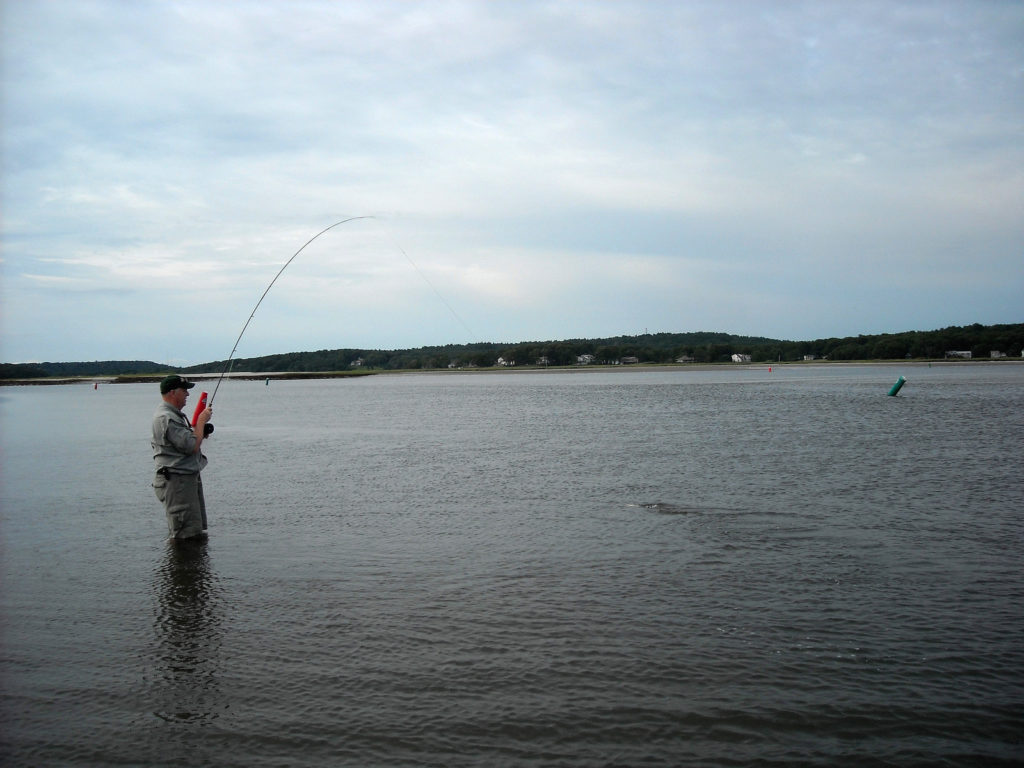 Fishing for Striped Bass
Fishing for Striped Bass
Trout are probably the only fish that have been written about more than striped bass. If you’ve ever done any striper fishing, the odds are that you’ve read articles and books dedicated to telling you how to catch them – with every fishing device known to man.
So why are striped bass so popular? For starters, as we’ve seen, they get big. Bass are also an exceptional food fish (if you’ve never had baked, stuffed striped bass, you’ve lived a life of extreme deprivation). But their biggest attraction may be that, in the good years, they are numerous and accessible, and they eat almost everything that they can fit their big jaws around, including big plugs that splash in the night.
There are some old pilings in the Weymouth Back River that I would often cast a fly to back when I still fished from a skiff. Upon bringing a bass to the side of the boat, I’d grab it by the lower lip so that I could remove the fly as quickly, and with as little harm, as possible. Often, at that location, I’d look down into the open mouth of the bass, and there would be a crab waving its claws at me from the bass’s gullet.
Bass may have the most varied diet of any fish that swims, which means that there are numbers of ways to catch them. That diet includes, but is not limited to worms, shellfish, crabs, lobsters, eels, sand eels, silversides, mackerel, mullets, herring, menhaden, snapper blues and each other. They often feed in schools, violently pursuing small fish like sand eels, tinker mackerel, or silversides (sperling) near the surface. When cinder worms are hatching in the rivers or salt ponds, they can be seen sipping the worms like trout eating mayflies. Big bass lurking below schools of menhaden will charge up into the bunched fish smashing them with their broad tails, at which point they’ll turn and swallow any menhaden that were stunned by the attack.
The popularity of striped bass is due, in large part, to their habits as an inshore fish that are ideally suited to take full advantage of the biodiversity and productivity of near shore habitats, like rivers, bays, estuaries and beachfronts. There is no other species of fish that is as accessible to a person standing on a beach, or the bank of a tidal creek that grows to such size, or is present in such numbers.
So it should come as no surprise that there are several “schools” (methods) for fishing for striped bass that have evolved over time.
Bait
Bait fishing is, reasonably, the first that comes to mind, and it probably encompasses the most numerous techniques. Some are pretty simple, like “chunking”, which entails putting a chunk of mackerel or menhaden on a hook, tossing it out, putting the rod in a sand spike or rod holder, and sitting down until a bass picks up the chunk and begins to move off with it. Floating sea worms under giant bobbers, or drifting then in the current is another. Live lining, or swimming live fish, like mackerel, or menhaden is popular for catching bigger bass, as is trolling live fish behind a moving boat. Clam strips are another popular bait. Meanwhile, tossing live eels in the dark of the night is an art.
The issue with live bait is the timing of the hook set. Typically, the angler gives the bass time to begin swallowing the bait before setting the hook. With live bait, like menhaden, the bass will move off with the bait and then stop to turn the fish and swallow it. That is the time to set the hook. The problem is that, with 90% of all bass caught being undersized, bass that are hooked deeply (gut hooked) are often released only to die. A partial answer to this problem is the circle hook, which will slide out to catch on the lip of the fish. Thus the new striped bass fishing regulations for 2020 mandated the use of inline circle hooks when using live or cut natural bait in Massachusetts to reduce mortality.
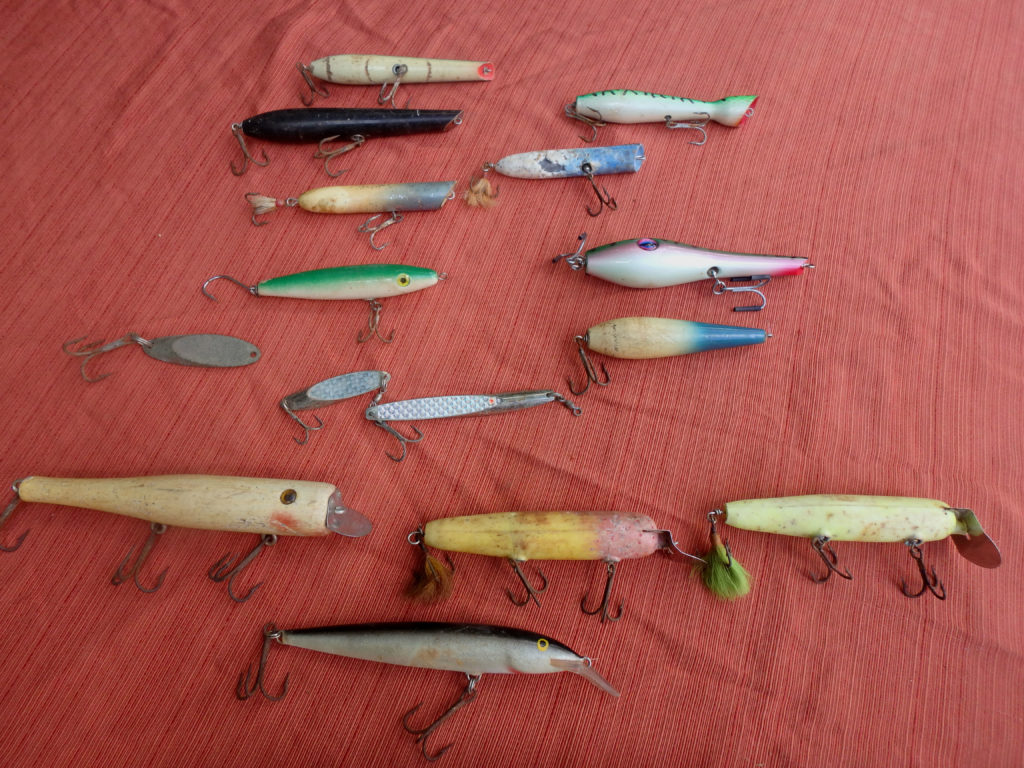
Plugs and “Tins”
Thanks to the fact that striped bass of all sizes are voracious predators, you don’t need bait to catch them. The lures that will take striped bass are too numerous to list here. Some, like poppers, make a surface commotion that will draw the attention of bass, while other plugs wobble or swim and dive. Then there are the metal lures that flash and wobble as they are retrieved, and finally there are jigs that are fished near the bottom. One very strange looking, but incredibly effective lure is just a big plastic tube tipped with a sea worm on the hook (tube and worm) that is trolled behind a boat. For some reason bass that are even smaller than the lure will hit these devices.
Surf casters throwing plugs and “tins” off the outer beaches of Cape Cod are the true icons of striped bass fishing. These are the “pluggers” and “hardware “ flingers that cruise the dunes in beach buggies, fish all night, and sleep (unless there’s a blitz) through much of the day. The fact is that bass do much of their beachfront feeding during low light periods.
This type of striper fishing off the beach became popular after WWII and reached its zenith during the 1960s and 70s. It owed much of its early popularity to Henry Lyman, Frank Woolner and the publication “The Saltwater Sportsman”, helmed by Lyman and edited by Woolner. I have friends who still buy their National Seashore season passes and spend several nights each summer tossing plugs into the Outer Cape’s surf.
Another group of iconic bass anglers are known as the “Canal Rats”. Canal Rats are dedicated to “The Big Ditch”(Cape Cod Canal) where they follow the tides and the fish using specially rigged bicycles. This group prides itself on their long distance casting and their knowledge of where the fish will be along the ditch during a particular stage of the tide. They often design and make their own plugs, or they purchase hand made plugs from their fellow Canal specialists. They are known to be a secretive, cultish bunch who have little tolerance for anglers who fail to respect the “social distancing” that has long been a key ethic of the hard core Canal Rat.
Fly Fishing
While fly-fishing for stripers is considered by many to be a new method for catching striped bass, it has actually been around for a long time, certainly a lot longer than spin casting, a method that arrived from France at the end of WWII and owes much to the invention of monofilament lines. Theodore Lyman III recorded that striped bass were being caught on flies in Buttermilk Bay back in the 1870s. During WWII the brothers Harold and Frank Gibbs began fly-fishing for striped bass in the Barrington and Warren Rivers, near their homes in Rhode Island, because they were unable to travel to Canada for salmon. At about the same time Joe Brooks and Lefty Kreh were catching striped bass with fly rods in Maryland. Back in the early 90s, I met an elderly lobsterman who told me that Ted Williams used to hire his boat to fly fish for striped bass in the North River; this would have been during the 1950s. The “Splendid Splinter” also fly fished for stripers with the Gibbs brothers and Al Brewster. Harold Gibbs and Brewster went on to found the Rhody Flyrodders in the 1960s.
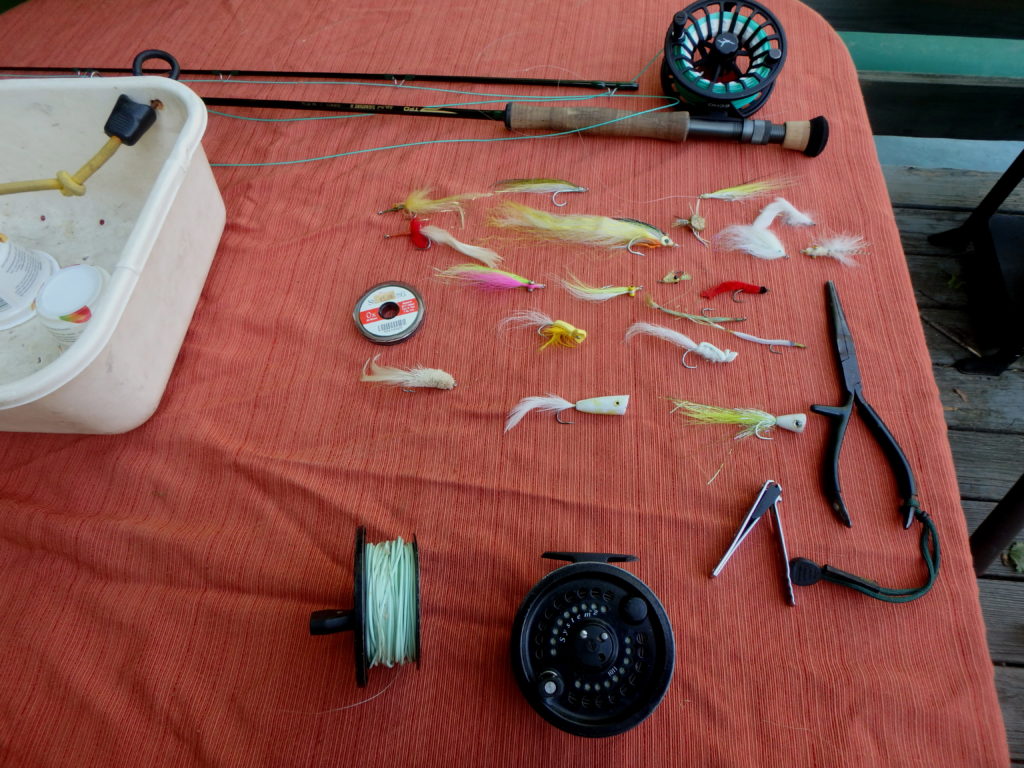
By the time that I started fly fishing for striped bass and bluefish in the 1980s, technological advances in fly lines and rods had turned fly fishing into an extremely efficient way to pursue striped bass. With fast sinking lines and weighted flies, like the Clouser Minnow, we were able to reach bass in water deeper than 30 feet. The heavier, longer rods needed for coping with the winds and the bigger, stronger fish of saltwater, were now far lighter and far more powerful than the bamboo and early fiberglass rods that Harold and Frank Gibbs had fished for bass with. Between the technical advances and the return of the Chesapeake striped bass in the 1990s, the popularity of fly fishing for striped bass took off, and that popularity continues to grow today.
The reasons for the popularity of fly fishing for striped bass become clear when we look (again) at the habits of the fish. Its varied diet, preference for feeding in rivers and estuaries, and for trapping its prey up against a beach front or the bank of a marsh, make it the ideal saltwater fish for the fly rodder. What the fly rod might lack in casting distance is more than made up for by its versatility. Flies can be tied to roughly imitate almost anything that a striper might eat, and given the options that floating, intermediate and sinking fly lines provide, there are many ways to present those flies. And when we consider that striped bass most often prefer to let the currents (tide) bring the food to them, well that is the type of fishing that flies and fly rods were originally designed for.
But no matter what your chosen method of fishing, the North and South Rivers are as fine a place to fish for striped bass as any on the South Shore. Whether it’s paddling a kayak out to the Spit at dawn, or catching the dropping tide at the Marshfield canoe launch, the beauty of the river is enough of a reward by itself. Feeling the hard tug of a striped bass when it hits your lure or fly is a bonus. There is a reason why the image of that long ago striped bass at Fourth Cliff stays with me. It is the setting as much as it is the fish.

